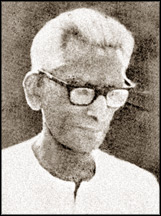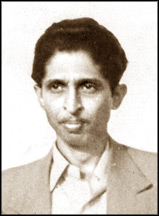|
The Leftist Movement in Sri Lanka:
The contest for Negombo in 1947 parliamentary elections
W.T.A. Leslie FERNANDO
When the Soulbery Constitution was introduced, the LSSP and the BLPI
agitated for a general election accusing that the State Council for
which the members were elected in 1936 was outdated. By this time the
Communist Party which backed the war effort of the Government joined the
Leftist camp.
In 1946 D.S. Senanayake formed the UNP in a hurry to face the general
election. It was a combination of National Congress, Sinhala Maha Sabha
led by S.W.R.D. Bandaranaike and few other Tamils and Muslims of
standing.
 |
 |
| Santiago
Fernando |
Edmund Samarakkody
|
The 1947 elections under the Soulbury Constitution were held for the
first time according to the political party system. The UNP put forward
98 candidates, LSSP 28, Communist Party 13 and the BLPI 10.
The Tamil Congress contested some seats in Northern and Eastern
provinces and the Ceylon Indian Congress contested some seats in the
plantations. There were a large number of independents in the fray. The
UNP considered some electorates as `open seats’ and nominated several
for them.
The UNP pledged to obtain independence without shedding a drop of
blood. It condemned Marxist parties as destructive and raised the
religious issue against them. It carried a poster campaign all over the
country indicating, “Let us save the religion from the Samsamajist
fire.”
The Leftist parties banded the UNP as a reactionary force and
emphasised that the burning problems of people could be solved only with
a socialist program. Although there was a no-contest pact between the
LSSP and the BLPI, both the parties clashed with the CP in a few
electorates.
There was a three-cornered contest for the Negombo seat. The sitting
member for Negombo in the State Council, H. de Z. Siriwardena was the
UNP candidate. Santiago Fernando was the LSSP nominee.
A.L.J. Croos Rajchandra contested as an independent. At the beginning
the Catholic Church backed Rajchandra who was the President of the
Catholic Union, the most powerful Catholic lay organisation.
However when it realised that the poor in Negombo were rallying round
the LSSP candidate it got alarmed and began to support the only Buddhist
candidate, H.de Z Siriwardena of the UNP.
The contest for the Negombo seat was the cynosure of all Catholics in
Sri Lanka. Negombo was a Catholic fortress and it was the electorate
that had the highest percentage of Catholics. Besides, the LSSP
candidate Santiago Fernando was a person who was expelled from the
position of teacher of a Catholic school for his Leftist leanings. As
such the Catholic Church joined hands with the rich and powerful in
Negombo to defeat him.
The reactionary forces used all the tactics against Santiago
Fernando. The Catholic clergy in their sermons from the pulpit in
churches instructed devotees not to vote for Santiago. All the Catholic
organisations too were deployed against him. The Catholic Church branded
the LSSP as an anti-religious organisation.
The other two candidates except for Santiago Fernando were lawyers
A.L.J. Croos Rajchandra was an advocate and H.de Z. Siriwardena was a
proctor. Santiago Fernando was only a Sinhala teacher.
The reactionary elements questioned whether the English knowledge of
Santiago Fernando would be sufficient enough to participate in the
proceedings in Parliament.
Santiago Fernando replied that he has been a member of the Negombo
Urban Council for two consecutive terms and his knowledge of English
would be more than sufficient to function as a MP as well.
At that time Santiago Fernando had proposed a resolution in the
Negombo UC demanding Central College for Negombo. His opponents made use
of this too as a weapon against Santiago Fernando.
They distributed a pamphlet in Negombo saying that Santiago Fernando
has been clamouring for a Central School in Negombo amidst all the
Catholic schools was a traitor to the religion. Santiago Fernando too
issued a pamphlet in reply pointing out that all the superior Catholic
schools in Negombo were meant only for the rich and a Central College
would benefit the poor Catholic children.
There were also many pamphlets in Negombo degrading the poor
candidate Santiago Fernando.An English version of a verse reads
thus:”Let us take a cart - And tie Santiago the Bull to it, Dabarera
would drive it - And Siriwardena will ride in it.’(A.L.J. Croos
Rajchandra was popularly known in Negombo by his former surname Dabarera)
When Santigao Fernando became a villain for all the rich and
reactionary elements, he became more and more popular among the poor
voters. Swabasha teachers, drivers, tailors and barbers were among the
commoners who played a prominent role in the campaign of Santiago
Fernando.
The election for the Negombo seat was held on September 16, 1947. At
that time symbols were not allotted according to the parties. The symbol
of H.de Z. Siriwardena was butterfly and Santiago Fernando got elephant.
Star was the symbol of A.L.J. Croos Rajchandra.
On the election day green flags with butterfly symbol was prominent
all over Negombo, and there was a considerable amount of blue flags with
star symbol. However, the few red flags with the elephant symbol found
here but they were more striking.
When Santiago visited the polling booths on the election day in a car
provided by his supporters, many poor voters awaiting for his arrival at
the polling booths with great enthusiasm applauded with joy to welcome
him. In some places poor voters were seen staging a procession with a
red banner ahead of them in support of him. The general consensus was
that Santiago Fernando would win the seat.
Later however the things took a different turn. At that time the
candidates provided transport for voters. Santiago Fernando who was a
poor and helpless guy without proper employment at the time could not
afford to provide vehicles for the purpose.
So he surreptitiously instructed voters to go in cars provided by the
opponents and vote for him. By noon there was suspicion about the role
of the drivers of cars provided by his main opponent, and they were
stopped from transporting voters. As a result there was a low poll in
the Negombo electorate and only 43% had exercised the vote. There was
also some well organised impersonation.
Besides it was later revealed that the Leftist BLPI had helped the
UNP candidate on the sly. So at the end of a keenly fought election, the
LSSP candidate Santiago Fernando lost the Negombo seat to the UNP rival
H.de Z. Siriwardena by a narrow margin of 956 votes.This is how the book
`History of Elections in Sri Lanka’ by S. Piyasena in Sinhala describes
that election for Negombo.
“By 1947 the election rivalry according to the Party system had
reached Negombo as well. The main rival of the UNP candidates in Negombo,
H.de Z. Siriwardena was a Samasamajist. He was none other than Santiago
Fernando, an enthusiastic member of the LSSP, almost from its inception,
prolific writer who wrote at length to the Leftist journals on the
Catholic Church and Marxism and bold and upright teacher popularly known
as Santhi Gurunnanse.
“The UNP expected an easy victory in Negombo, the Catholic stronghold
as the Catholics were believed to be against the Marxist LSSP. But soon
they found that it was not so easy going as the fisherfolk began to
rally round Santiago saying “Poor voters in Negombo would vote for Poor
Santhi Gurunnanse Ultimately, UNP could win Negombo only by a slender
Margin of 956 votes.”
Although Santiago Fernando lost the seat by a slender majority it was
evident that LSSP had made headway in Negombo. The power struggle in
Negombo was an inspiration for many Catholics in Catholic strongholds
like Ja-ela and Nattandiya to vote against the UNP. In some other
electorates like Moratuwa, Panadura, Kalutara, Colombo and Avissawella
where there was a considerable Catholic population many Catholics backed
the Leftist parties.
According to the Soulbury Constitution for the first Senate of 15
members were appointed by the Governor and 15 were elected by the
members of the House of Representatives. There was a move to elect
Santiago Fernando who lost Negombo by a narrow margin from the LSSp and
Edmund Samarkkody who contested D.S. Senanayake from the BLPI to the
Senate. But as the two parties made a policy decision not to elect
defeated candidates to the Senate, Santiago Fernando missed a chance of
entering the Senate as well. |

